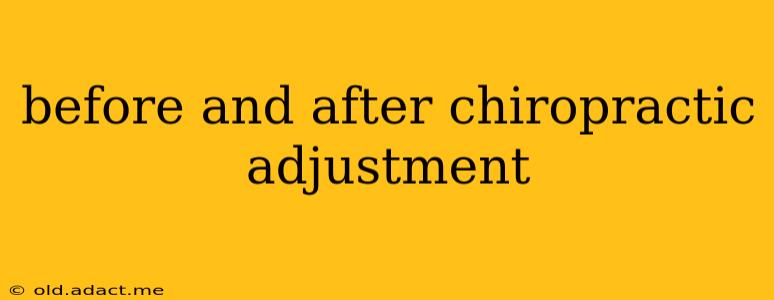Chiropractic adjustments are a common treatment for musculoskeletal pain and dysfunction. Understanding what to expect both before and after an adjustment can help manage expectations and maximize the benefits of this therapy. This comprehensive guide will explore the process, potential sensations, and recovery, answering many frequently asked questions about the chiropractic experience.
What Happens Before a Chiropractic Adjustment?
Before your first chiropractic adjustment, you'll undergo a thorough examination. This typically includes:
- Medical History Review: Your chiropractor will ask detailed questions about your medical history, current symptoms, and any past injuries. This is crucial for developing a personalized treatment plan.
- Physical Examination: A physical exam involves assessing your posture, range of motion, and palpating (feeling) your spine and muscles to identify areas of restriction or discomfort. This might include neurological tests to rule out nerve involvement.
- Diagnostic Imaging (if necessary): In some cases, X-rays or other imaging studies might be recommended to get a clearer picture of your spinal alignment and identify any underlying conditions. This is not always necessary, but it can be helpful in certain situations.
Following the examination, your chiropractor will discuss their findings and propose a treatment plan, which may include chiropractic adjustments, therapeutic exercises, lifestyle advice, or other modalities.
What Happens During a Chiropractic Adjustment?
A chiropractic adjustment is a highly specific, controlled manipulation of a joint. The goal is to restore proper joint motion and reduce muscle tension. The procedure itself usually involves:
- Precise Positioning: You'll be positioned on the adjusting table in a way that allows the chiropractor to target the specific joint requiring adjustment.
- Controlled Thrust: The chiropractor uses a quick, controlled thrust to restore joint movement. The force used varies depending on the individual and the specific area being treated. This often creates an audible "pop" or "crack" which is the sound of gas bubbles releasing from the joint. This is completely normal and generally harmless.
- Post-Adjustment Assessment: After the adjustment, the chiropractor might re-evaluate your range of motion and assess your comfort level.
What to Expect After a Chiropractic Adjustment?
The experience after a chiropractic adjustment varies from person to person. Some common sensations include:
- Improved Range of Motion: You might feel an immediate increase in flexibility and range of motion in the adjusted area.
- Reduced Pain: Many people experience a reduction in pain and stiffness immediately following an adjustment, though it's not always instantaneous. The improvement may be gradual over several sessions.
- Mild Soreness or Discomfort: Some individuals experience mild muscle soreness or discomfort for a day or two following the adjustment. This is usually temporary and subsides quickly.
How long does it take to feel better after a chiropractic adjustment?
The timeframe for feeling better after a chiropractic adjustment varies considerably. Some individuals feel immediate relief, while others may need several sessions to notice significant improvements. The complexity of the condition and the individual's response to treatment greatly influence the recovery time.
What are the benefits of chiropractic adjustments?
Chiropractic adjustments are frequently used to address a wide array of musculoskeletal issues, including back pain, neck pain, headaches, sciatica, and other joint pain. Benefits may include reduced pain, improved mobility, enhanced posture, and improved overall function.
What are some potential side effects of a chiropractic adjustment?
While generally safe, chiropractic adjustments can sometimes cause mild side effects such as muscle soreness, fatigue, or headache. These side effects are usually temporary and resolve quickly. Severe side effects are rare.
How many chiropractic adjustments are needed?
The number of chiropractic adjustments needed depends on the individual, the severity of their condition, and their response to treatment. Some people may only need a few adjustments, while others may require a longer course of treatment. Your chiropractor will create a treatment plan based on your specific needs.
When to See a Chiropractor
It's always best to consult a healthcare professional for any pain or discomfort. Chiropractic care might be a beneficial option for various musculoskeletal issues but isn't suitable for all conditions. A thorough consultation with a qualified chiropractor will help determine if chiropractic care is the right approach for you. Remember, this information is for general knowledge and doesn't constitute medical advice. Always consult your doctor or a qualified chiropractor before starting any treatment plan.
